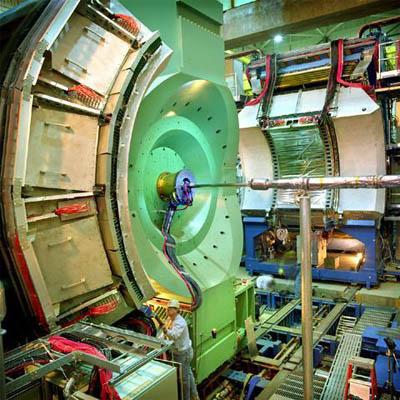
Program details:
-
Ten weeks
-
Stipend $7,000
-
Travel, housing, meals provided
Application deadline:
February 3 - March 3
(offers made on a rolling basis during this window).
Program dates:
May 26 - Aug 1
Research Experiences for Undergraduates
Summer 2025
Vanderbilt University
Physics & Astronomy
Research Projects: Particle (LHC) and High-Energy Nuclear (RHIC and LHC) Physics
Study
of the Charm and Beauty Quarks
(Profs. Paul Sheldon, Will Johns)
This elementary particle physics (EPP) research group is investigating
fundamental questions about the structure and behaviour of the universe.
Their work provides information about the weak and strong forces (counterparts
to gravity and electromagnetism) and offers sensitive probes for new fundamental
phenomena. They are major contributors to two active experiments: the
FOCUS experiment at the Fermi National Accelerator Laboratory (Fermilab),
near Chicago, Illinois, and the CMS experiment at CERN in Geneva, Switzerland.
The CMS experiment will operate at the highest energies ever achieved
for particle collisions. They hope to find new and exotic states of matter
that shed light on the physics described above. The FOCUS experiment has
finished data taking; the group is still producing interesting results
on properties of particles containing a charm quark. Undergraduates in
the group have performed published work on charm decays from FOCUS, worked
on detector development, and participated in large scale computing projects.
An REU student could be expected to participate on FOCUS or perform physics
simulations for CMS.
High Energy Nuclear Physics - Experiment and Theory
(Profs. Julia
Velkovska, Raghav Kunnawalkam Elayavalli, Jean-Francois Paquet, S.
Victoria Greene, and Yi Chen)
Quarks and gluons are the elementary constituents of protons and neutrons. Microseconds after the Big Bang, the temperature of the Universe was so high that quarks and gluons were not yet trapped into protons and neutrons and existed as a deconfined plasma that permeated the Universe. This quark-gluon plasma (QGP) is now recreated and studied in the laboratory by colliding heavy nuclei at velocities close to the speed of light. The only two facilities capable of this are the Relativistic Heavy Ion Collider (RHIC) at Brookhaven National Laboratory (New York) and the Large Hadron Collider at CERN (Switzerland). The high-energy nuclear physics group at Vanderbilt takes part in the activities of both RHIC and LHC, building detectors and hardware, analyzing the measurements, performing numerical simulations and developing models to study the properties of this unique phase of matter. The group is also strongly involved in the future electron-ion collider, which will collide high-energy electrons with nuclei, allowing an unprecedented view into the structure of nuclei across varying length scales. A number of different student projects are available both on the experimental and theoretical fronts. Students will have the opportunity to look at brand new data from the sPHENIX experiment at RHIC and also from recent runs from the CMS experiment at the LHC, or to participate in hands-on activities in our state-of-the-art micro-pattern gaseous detector lab. The group also has multiple projects on numerical simulations such as studies of Monte Carlo event generators, relativistic fluid dynamics, kinetic theory, jet-QGP interactions, and novel applications of Bayesian inference and machine learning to nuclear physics. Students can further take part in the activities of the VandyGRAF Initiative, which studies mathematical and physical aspect of general relativity and fluid dynamics, including black holes and neutron-star mergers.
Experimental particle physics at CERN
(Prof. Alfred Gurrola)
As far as we know, everything in our universe is made from basic building blocks called fundamental particles. Our best understanding of how these particles interact is encapsulated in a mathematical framework called the Standerd Model (SM). The SM model is incomplete, both at the smallest scales and at the largest scales. The central thrust of this research group is to use collider experiments to (1) search for new physics that connect cosmology with particle physics, and (2) understand particles and forces at high-energy scales. The REU student will carry out work on both the experimental and theoretical fronts. On the experimental side, they will take advantage of the rich particle physics program at the LHC as mebers of the Compact Muon Solenoid (CMS) collaboration. On the theory side, the student will combine collider simulations with new particle physics models. The student will facilitate collaborations with experts in various scientific disciplines, resulting in a synergistic mission to strengthen particle physics research endeavors that may lead to novel experimental techniques to descover new physics and to address important, unanswered questions.
 These
web pages are copyrighted by Vanderbilt University, and are based upon
work supported by the National Science Foundation. Any opinions, findings,
and conclusions or recommendations expressed are those of the authors
and do not necessarily reflect the views of the National Science Foundation.
These
web pages are copyrighted by Vanderbilt University, and are based upon
work supported by the National Science Foundation. Any opinions, findings,
and conclusions or recommendations expressed are those of the authors
and do not necessarily reflect the views of the National Science Foundation.
Vanderbilt Physics and Astronomy
Vanderbilt Data Science Institute
Frist Center for Autism & Innovation

Vanderbilt
University is located near downtown Nashville.

